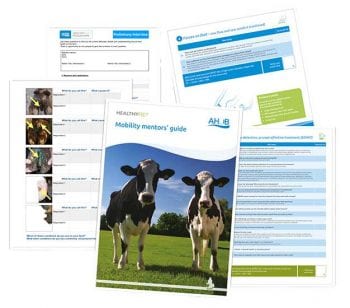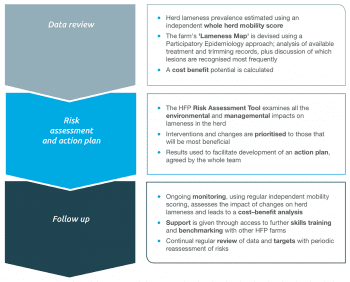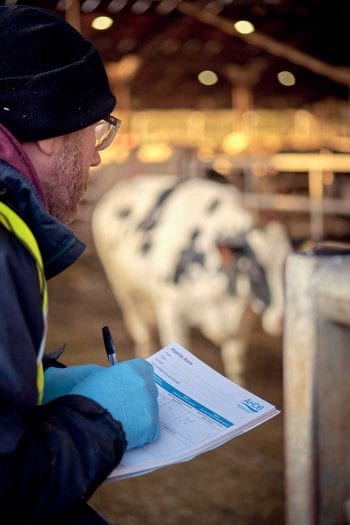22 Sept 2020
Nick Bell MA, VetMB, PhD, PGCert Vet Ed, FHEA, DipECAWBM(AWSEL), MRCVS, Owen Atkinson BVSc, DCHP, MRCVS and Sara Pedersen BSc(Hons), BVetMed, CertCHP, DBR, MRCVS discuss the benefits of two structured programmes dealing with lame dairy cows that vets can use with clients.

In 2011 the Healthy Feet Programme was launched by DairyCo (now the Agriculture and Horticulture Development Board; AHDB) as a structured programme for addressing lameness in dairy cows for vets and trimmers to use with their clients.

Built on principles developed in a University of Bristol research project (the Healthy Feet Project), the addition of a skills review – with revisits, quarterly mobility scores and progress reports – has made it one of the most comprehensive approaches available to dairy farmers working on lameness.
This year, a streamlined version of the full programme is being launched by the AHDB, called Healthy Feet Lite (HF Lite), aimed at making specific elements of the Healthy Feet Programme more accessible to farmers. This cut‑down version may suit farmers wanting an easier or less costly start, or when a farmer perceives a specific problem that does not warrant the full programme (for example, a problem with just digital dermatitis control or foot bathing). Furthermore, HF Lite should be easier for advisors to market to farmers and then deliver.
The launch of HF Lite coincides with the recent broadening of eligibility criteria for new mobility mentors (the name given to the programme deliverers and facilitators), which now includes other suitably qualified advisors, as well as vets and qualifying trimmers.
The full programme involves the capture and review of lameness and mobility data, systematic risk assessments, trimming and treatment skills review, and the development of a facilitated team action plan (Figure 1).
Data analysis is done by using quarterly (at least) herd mobility scores by a Register of Mobility Scorers (RoMS)-accredited scorer (Figure 2) and review of lesions causing lameness from the records.
The major lesions causing lameness (sole ulcers, white line lesions and digital dermatitis) are plotted on the lameness map (Figure 3). Risks are reviewed by means of a set of checklists completed at milking and by walking the routes milking cows follow, with visits to see dry cows and youngstock.

A selection of lame and routine foot check cows are then drafted for examination in the farm’s trimming facilities. The purpose is to assess whether facilities are fit for purpose, as well as to see the condition of feet, and observe the skills and confidence of the trimmer (Figure 4).
This completes the assessment ready for the facilitated meeting, and usually requires at least two visits.
The action planning stage is better to happen off farm at a separate meeting, away from distractions. The use of facilitation is the core strategy for maximising uptake of ideas and problem-solving – important for most people dealing with complex and competing problems.
For example, improvement of lying behaviour is known to help reduce claw horn disruption (bruising, sole ulcers and white line lesions), but many ways exist in which a farm could improve lying times.
A highly effective way may involve managing small groups of cows in straw yards, but mastitis control and lack of affordable straw are competing concerns. A comfortable fresh group is often more practical, but splitting groups and changing stocking rates could be equally effective.
The facilitation also allows for a range of management priorities and practical solutions to be weighed up by the team, generating the crucial details for a committed change. The benefits of general cow and staff welfare can be considered, too. Facilitation encourages the necessary “change talk”, while building self‑efficacy (Miller and Rollnick, 2012).
Since the launch of the Healthy Feet Programme in 2011, more than 140 vets, trimmers and consultants have been trained as mobility mentors.
Unfortunately, uptake of the full programme by farmers is unknown and probably slow. However, without a formal registration and enrolment process for farmers, no means exists of measuring its full impact.
Some of the resources have been the most requested by the AHDB, showing elements of the programme are popular even though the formal programme isn’t followed.
The full process of gathering data, risk assessments and facilitating a team meeting can be time-consuming and daunting for busy advisors and farmers – particularly if the farmer, at this stage, may believe all he or she needs to know is what to put in a foot bath and how many times a year to trim a cow.
Hence, HF Lite was created to give the mobility mentors the chance to gather some initial data and start the process of talking about other concepts, as well as answering the immediate questions.
The HF Lite protocol is designed to be delivered in a single visit lasting two to three hours following a mobility score. HF Lite retains elements of the full programme (Table 1) and is similar to the original research project that ran at Bristol between 2006-10 – the Healthy Feet Project.
The approach was created for roll-out by trained facilitator technicians and researchers visiting 227 participating farms each year for four years (Main et al, 2012).

Like the full programme, HF Lite starts with a mobility score with a review of trimming and treatment records. Mobility scoring can be prone to inter-observer variability, so it is stipulated that a RoMS-accredited scorer should be used to reduce some of the error.
The same checklists are used for risk assessment, although it may not be feasible to conduct the same detailed level of investigation possible with a dedicated visit offered within the full programme – especially for larger farmers.
The skills review is removed from HF Lite. This stage is time-consuming and may not be relevant to farmers with the best trimming training and equipment. It may also be daunting for mobility mentors unpractised at trimming.
For mobility mentors who are trimmers, the skills check may be inherently less relevant to gaining new and valuable insights. However, the skills review is undoubtedly one of the most important elements in the full programme, invariably throwing up many crucial observations and findings, so the hope is many farmers opt to progress on to the full programme with the added confidence gained from HF Lite.
The visit ends with the writing of the farmer’s own action plan by the facilitator. It is important that these actions are determined by the farmer. This one-to-one or three-person meeting misses some of the benefit of the team brainstorming and more detailed problem-solving in the full programme. However, this is often enough to initiate action and gain some momentum.
The only follow-up could be a courtesy call within a few weeks of the visit to offer support and further encouragement. Farms can be re-enrolled on to HF Lite annually from then on.
The expectation on the farmer is perhaps gentler and more realistic for many of them. For many farms this is sufficient to drive major change through raised awareness and better focus on the main priorities, as reported following the Healthy Feet Project (Main et al, 2012).
Lameness is a major welfare and economic problem, but despite the concern, its prevalence has remained more than 30% of dairy cows affected in Great Britain (Randall et al, 2019).
The Healthy Feet Programme and HF Lite offers an exciting means for vets, trimmers and other suitably qualified advisors to support their clients. For further details, readers are directed to:
The authors would like to thank the various contributors to the development of the Healthy Feet Programme and HF Lite.
There have been so many, including support from the AHDB (especially Derek, Jenny and Janet), the Healthy Feet Project team (especially David) and the Mobility Steering Group (especially Jane who suggested the creation of the streamlined version).